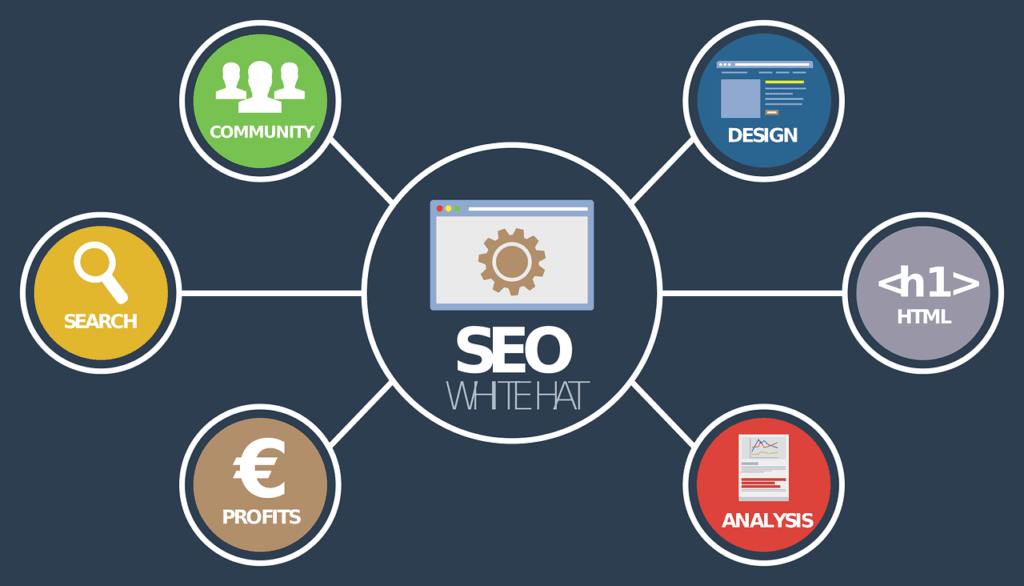(This Article has been revised, edited and added to, by Poulomi Chakraborty.)
- Understanding the Terrain: Business Banking Meets SEO
- The Intersection of User Intent and Financial Expertise
- Navigating the SEO Maze: Practical Strategies for Business Banking Sites
- Fine-Tuning the Machine: Website Optimization and Link-Building Strategies
- Mastering Metrics: Measuring SEO Success and Strategic Adjustments
- Beyond Basic Analytics: Advanced Data Insights
- Conclusion
In today’s digital age, navigating the vast ocean of online content can be daunting for any business, especially for those in the banking sector. With the intricacies of corporate cash flow and the complexities of financial management, business banking websites face the unique challenge of standing out in an ever-competitive online landscape. This is where the magic of SEO (Search Engine Optimization) comes into play. But fear not, as we delve into the world of SEO for business banking websites, we’ll keep things light, engaging, and, most importantly, simple.
Understanding the Terrain: Business Banking Meets SEO
Imagine you’re planning a cross-country road trip. Your business banking website is your vehicle, and SEO is the fuel that propels you forward, ensuring you reach your destination – the coveted first page of search engine results. The journey isn’t just about speed; it’s about making sure you’re visible to those looking for the services you provide. This visibility is crucial in managing and enhancing corporate cash flow through online channels.
The Intersection of User Intent and Financial Expertise

One critical area of comparison in the realm of SEO for business banking sites is the alignment of user intent with financial expertise. On one hand, we have user intent – the driving force behind every search query. On the other hand, there’s the dense, often complex world of financial expertise that your website embodies. Bridging these two elements is where the real challenge lies.
Crafting Content that Speaks
To truly resonate with your audience, your content must do more than just showcase your financial acumen. It needs to answer the questions that keep business owners up at night:
- “How can I better manage my company’s cash flow?”
- “What are the best business banking solutions for my small enterprise?”
This means translating your deep financial knowledge into accessible, engaging content that addresses these pain points directly. It’s not just about providing answers; it’s about crafting a narrative that positions your bank as the trusted advisor in all things business finance.
SEO and the Art of Keyword Mastery
Keywords are the signposts that guide potential clients to your content. However, the real art lies in integrating these keywords naturally within your content, ensuring that it remains informative and engaging. This is where many business banking websites stumble. They either overload their content with technical jargon and complex financial terms or, in the pursuit of SEO, stuff their articles with keywords, sacrificing readability and engagement.
The sweet spot is a harmonious blend of technical expertise and layman’s language, peppered with carefully researched keywords that mirror the actual search queries of your target audience. It’s about understanding the questions your potential clients are asking and weaving the answers into your content in a way that feels organic and helpful.
The intersection of user intent and financial expertise in SEO for business banking websites is a delicate dance. On one side, there’s the need to showcase your financial knowledge and services; on the other, the imperative to meet your potential clients where they are, in language they understand and appreciate. Striking the right balance can transform your website from just another banking service provider into a beacon of guidance in the complex world of corporate finance.
Navigating the SEO Maze: Practical Strategies for Business Banking Sites

With a solid understanding of the crucial balance between user intent and financial expertise, let’s dive deeper into the practical strategies that can elevate your business banking website’s SEO game. It’s time to turn theory into action, focusing on actionable steps that blend SEO best practices with the unique needs of the financial sector.
Keyword Research: The Foundation of Your SEO Strategy
At the heart of any successful SEO strategy lies comprehensive keyword research. This isn’t about guessing what potential clients might be searching for; it’s about using data to uncover the exact phrases and questions they use when looking for financial services online.
Utilizing SEO Tools for Deeper Insights
Leverage SEO tools like Google’s Keyword Planner, SEMrush, or Ahrefs to delve into keyword metrics. These tools offer insights into search volume, competition level, and keyword relevance. The goal is to identify both high-volume keywords and long-tail phrases that reflect specific user intents. For instance, a term like “business banking solutions” might have a high search volume, but a longer, more specific phrase such as “how to improve business cash flow with banking” can attract a more targeted audience.
Balancing Broad and Niche Keywords
Incorporating a mix of broad and niche keywords is key. Broad terms get you in front of a larger audience, while niche keywords, which often have lower competition, attract visitors with specific needs—those more likely to convert into clients. This blend ensures your site is visible at different stages of the customer journey, from awareness to decision-making.
Optimizing for Local SEO: Be Where Your Clients Are
For many business banking services, the target audience is often local. This is where local SEO comes into play, ensuring your website appears in search results when potential clients in your area are looking for banking solutions.
Claiming Your Google My Business Listing
An essential step in local SEO is claiming and optimizing your Google My Business (GMB) listing. This free listing increases your visibility in local search results and Google Maps, providing potential clients with easy access to your contact information, location, and hours of operation. Encourage satisfied clients to leave positive reviews on your GMB listing, as these can significantly influence prospective clients’ perceptions of your bank.
Local Keywords and Content
Incorporate local keywords into your website’s content, titles, and meta descriptions. If your bank serves multiple locations, consider creating location-specific pages, each optimized for local search terms relevant to that area. This not only improves your visibility in local searches but also provides a more personalized experience for website visitors.
Building Trust Through Quality Content
Quality content is the cornerstone of any SEO strategy, but for business banking websites, it’s also a powerful tool for building trust and authority in a highly competitive industry.
Blogging with Purpose
Maintain a blog that addresses common financial challenges and questions faced by businesses. Use your blog to showcase your expertise, offering actionable advice, industry insights, and case studies that illustrate how your banking solutions have helped other businesses succeed. This not only helps with SEO but also establishes your bank as a thought leader in the business finance space.
Video Content: A Visual Approach to Engagement
Videos can significantly enhance user engagement, offering a dynamic way to present complex financial concepts. Create tutorial videos, interviews with financial experts, or behind-the-scenes looks at your banking operations. These can improve dwell time (how long visitors stay on your site), which is a positive signal to search engines.
Cultivating a Unique Brand Voice Through SEO
For startup founders, establishing a distinct brand voice is crucial not only for standing out from the competition but also for connecting with your target audience on a more personal level. SEO can be a powerful tool in this endeavor, helping to weave your unique brand persona into the fabric of your online content.
Infusing Brand Personality into Your Keywords
Start by identifying keywords that not only reflect the services you offer but also resonate with the ethos of your brand. If your startup prides itself on simplicity and user-friendliness, opt for keywords that convey these qualities. This approach not only improves your SEO but also ensures that your brand voice is consistent across all digital touchpoints.
Tailoring Content to Reflect Your Brand’s Values
Create content that speaks directly to the values and needs of your target audience. For a startup in the business banking sector, this might involve crafting articles, blog posts, and videos that address the unique financial challenges faced by other startups and small businesses. By positioning your brand as a knowledgeable ally in their entrepreneurial journey, you foster trust and loyalty among your audience.
Leveraging Local SEO for Community Engagement
For many startups, the local community represents a critical first step towards broader market penetration. Local SEO can be a game-changer in this regard, making your services more visible to businesses in your immediate geographic area.
Hosting and Participating in Local Events
One strategic move is to host or participate in local business events, seminars, or workshops. Not only does this provide valuable networking opportunities, but it also generates local interest and backlinks to your website when these events are covered online. Make sure to promote these events through your website and social media channels, utilizing local keywords and hashtags to boost your visibility in local search results.
Collaborating with Local Businesses and Influencers
Forge partnerships with other local businesses and influencers in your community. These collaborations can lead to joint marketing efforts, guest blogging opportunities, and shared social media campaigns, all of which can enhance your local SEO and draw more traffic to your site. Additionally, these partnerships solidify your startup’s presence in the local business ecosystem, building brand awareness and credibility.
Prioritizing User Experience for Higher Conversion Rates
In the digital realm, user experience (UX) can significantly impact your site’s ability to convert visitors into leads or customers. For startups, optimizing UX is not just about aesthetics; it’s about creating a seamless, intuitive journey from the moment a user lands on your site to the point of conversion.
Streamlining Navigation and Site Structure
Ensure that your website is easy to navigate, with a clear, logical structure that guides visitors to the information they seek. A well-organized site not only improves UX but also helps search engines index your content more effectively, boosting your SEO.
Enhancing Interactivity and Engagement
Incorporate interactive elements into your website, such as chatbots for instant customer support, interactive calculators for financial planning, or personalized quizzes to recommend banking products. These features not only make your site more engaging but also provide value to your visitors, increasing the likelihood of conversion.
Fine-Tuning the Machine: Website Optimization and Link-Building Strategies

Once the foundation of keyword research and content creation is laid, it’s crucial to focus on the nuts and bolts of SEO: website optimization and link-building. These elements ensure your site is not only discoverable but also provides a seamless user experience that encourages engagement and conversion.
Enhancing Website Usability and Performance
In the digital banking sector, a website’s usability and performance can significantly influence a visitor’s decision to engage with your services. This aspect of SEO focuses on making your site fast, mobile-friendly, and easy to navigate.
Speed is of the Essence
Page loading speed is a critical factor in both SEO rankings and user experience. Utilize tools like Google’s PageSpeed Insights to identify and rectify issues that may be slowing down your site. Simple adjustments, such as optimizing images, minifying CSS and JavaScript files, and leveraging browser caching, can make a substantial difference.
Mobile Optimization: Catering to the On-the-Go User
With the increasing prevalence of mobile banking, ensuring your website is mobile-friendly is non-negotiable. A responsive design that adapts to different screen sizes and touch-based navigation can significantly enhance the mobile user experience, improving your site’s SEO performance and keeping you competitive in the mobile-first world.
Simplifying Navigation for Better User Experience
A well-structured website with clear, intuitive navigation helps users find the information they need quickly and efficiently. This includes a logical hierarchy, a clean menu structure, and a comprehensive sitemap. For business banking websites, simplifying the path to critical information—like account types, loan options, and support resources—can directly impact conversion rates.
Link-Building: Establishing Authority and Trust
In the realm of SEO, links are akin to endorsements. High-quality, relevant backlinks from reputable sites signal to search engines that your content is valuable and trustworthy, boosting your site’s authority and rankings.
Creating Link-Worthy Content
The first step in a successful link-building strategy is to create content that naturally attracts links. This includes in-depth guides, industry reports, and insightful analysis that offer real value to your audience and encourage other sites to link to your content as a resource.
Outreach and Relationship Building
Outreach is a proactive approach to link-building, involving contacting industry blogs, financial news sites, and related businesses to share your content. The goal is to foster relationships that lead to organic link-building opportunities. Offering to guest post on relevant sites can also be a mutually beneficial strategy, expanding your reach and establishing your bank’s thought leadership.
Monitoring and Managing Your Link Profile
Regularly monitor your site’s link profile using tools like Ahrefs or Moz. This helps identify and disavow any low-quality or spammy links that could harm your SEO performance. Maintaining a healthy link profile is crucial for long-term SEO success.
Advanced Technical SEO for Enhanced Visibility
For startups, establishing a robust online presence demands more than just surface-level optimization. Delving into the technicalities of SEO can unveil opportunities to significantly boost your website’s visibility and search engine compatibility.
Implementing Structured Data Markup
Structured data markup is a powerful tool that helps search engines understand the content of your website more effectively. By implementing schema markup, you can enhance the way your site appears in SERPs with rich snippets, which can include star ratings, FAQs, or events. This not only improves visibility but also makes your listings more attractive and informative to potential visitors, potentially increasing click-through rates.
Optimizing for Featured Snippets
Positioning your content to appear as a featured snippet at the top of Google’s search results can dramatically increase your site’s visibility. To target featured snippets, structure your content to directly answer questions related to your key business banking terms in a clear and concise manner. Use headings to break up the content, and consider including lists, tables, or bullet points, which are often preferred by Google for these snippets.
Developing a Strategic Link-Building Campaign
Beyond traditional link-building efforts, there’s a need for strategic campaigns that align with your startup’s goals and the specific interests of your audience. Crafting a campaign with a unique angle or based on original research can set you apart and attract high-quality backlinks.
Utilizing Original Research and Reports
One of the most effective ways to earn authoritative backlinks is by conducting original research or producing comprehensive industry reports relevant to the business banking sector. Original data and insights provide immense value to your audience and the wider industry, encouraging other websites and media outlets to link back to your findings.
Hosting Virtual Events and Webinars
In the digital age, virtual events and webinars have become invaluable tools for engaging with your audience and industry peers. Hosting these events not only positions your startup as a thought leader but also generates a plethora of backlinking opportunities through event listings, registrations, and post-event content distribution.
Enhancing User Engagement Through Technical Upgrades
User engagement is a critical factor in SEO success. Technical upgrades can significantly improve the user experience, keeping visitors on your site longer and encouraging them to interact with your content.
Accelerating Page Speed with Next-Gen Technologies
Leverage next-generation technologies like Accelerated Mobile Pages (AMP) and Progressive Web Apps (PWA) to boost your site’s loading speed, especially on mobile devices. Faster loading times contribute to a better user experience, reducing bounce rates and improving overall site performance in search engine rankings.
Implementing Intelligent User Analytics
Integrate advanced analytics tools that offer deeper insights into user behavior and interaction patterns on your website. Understanding how users engage with your site can help you make informed decisions on content strategy, site layout adjustments, and personalized user experiences to increase engagement and conversion rates.

Related: Check out our free SEO suite

Mastering Metrics: Measuring SEO Success and Strategic Adjustments
In the ever-evolving landscape of SEO, the ability to measure success and adapt your strategies based on analytics is what separates the leaders from the followers. For business banking websites, where the stakes are high and the competition fierce, understanding and leveraging SEO metrics can provide a significant competitive edge.
Setting the Stage with SEO Goals and KPIs
Before diving into the vast sea of analytics, it’s crucial to define what success looks like for your business banking site. Establishing clear SEO goals and Key Performance Indicators (KPIs) will guide your measurement efforts and ensure they align with your overall business objectives.
Common SEO KPIs for Business Banking Websites
- Organic Traffic: The number of visitors coming to your site through search engines. An increase in organic traffic indicates higher visibility and improved SEO performance.
- Keyword Rankings: The positions your website occupies in search engine results pages (SERPs) for targeted keywords. Tracking changes in rankings can help you gauge the effectiveness of your content and keyword strategies.
- Conversion Rate: The percentage of visitors who take a desired action on your site, such as signing up for an account or requesting more information. This metric is crucial for understanding how well your site turns traffic into leads or customers.
- Bounce Rate: The percentage of visitors who leave your site after viewing only one page. A high bounce rate may indicate that your content is not meeting users’ expectations or that your site is difficult to navigate.
- Page Loading Speed: Fast-loading pages are essential for both SEO and user experience. Monitoring this metric can help you identify and fix issues that could be hindering your site’s performance.
Analyzing Data to Inform Strategy
With your KPIs in hand, it’s time to dive into the analytics. Tools like Google Analytics and Google Search Console offer a wealth of data on how users interact with your site and how it performs in search results.
Identifying Trends and Opportunities
Use your analytics tools to monitor trends in organic traffic, keyword rankings, and other KPIs. Look for patterns, such as certain types of content that consistently attract more traffic or specific keywords that lead to higher conversion rates. These insights can help you identify what’s working and where there’s room for improvement.
Understanding User Behavior
Analytics can also provide valuable insights into user behavior on your site. For example, heatmaps and session recordings can show you how users interact with your content, which pages hold their attention, and where they encounter friction. This information is invaluable for optimizing the user experience and guiding visitors toward conversion.
Adjusting Your SEO Strategy Based on Insights
Armed with data, you’re in a position to make informed decisions about how to adjust your SEO strategy for better results.
Refining Content and Keywords
If certain pages or topics are driving more traffic and engagement, consider creating more content in those areas. Similarly, if some keywords are not performing as expected, it may be time to revisit your keyword research and adjust your focus.
Enhancing Site Usability and Performance
Analytics can highlight issues with site usability and performance that may be impacting your SEO. Whether it’s improving page loading speeds, making navigation more intuitive, or optimizing for mobile, making these adjustments can boost both your rankings and user satisfaction.
Building on Link-Building Success
Review your link profile regularly to identify which types of content are earning the most high-quality backlinks. Use this information to guide your content creation efforts, focusing on topics that are likely to attract links and shareable content.
Embracing Voice Search Optimization

As technology advances, voice search is becoming increasingly popular, thanks to the convenience it offers. People are using voice-activated devices like smartphones, smart speakers, and virtual assistants to perform searches more than ever before. For business banking websites, optimizing for voice search means adapting to more conversational queries and focusing on natural language processing.
How to Optimize for Voice Search
- Focus on Long-Tail Keywords: Voice searches are typically longer and more conversational than text searches. Incorporate long-tail keywords that mirror how people naturally speak.
- Create FAQ Pages: Frequently asked questions (FAQ) pages that answer common questions in a conversational tone are perfect for capturing voice searches.
- Improve Local SEO: Many voice searches are local in nature. Ensure your business banking services are optimized for local search to capture these queries.
Leveraging AI and Machine Learning
Artificial Intelligence (AI) and machine learning are revolutionizing the way we approach SEO. These technologies can analyze vast amounts of data to identify trends, predict user behavior, and personalize the user experience on your website.
Implementing AI for SEO Success
- Content Optimization: Use AI tools to analyze top-performing content and suggest topics that resonate with your audience.
- User Experience Personalization: AI can help personalize the website experience for visitors, displaying content or offers relevant to their interests and previous interactions.
- SEO Automation: Automate routine SEO tasks, such as keyword research and technical audits, allowing you to focus on strategy and content creation.
Integrating SEO with Overall Digital Marketing
SEO should not exist in a vacuum. Integrating it with your overall digital marketing strategy can amplify your online presence and drive more meaningful results.
Synergy with Social Media
Social media can significantly boost your SEO efforts by driving traffic to your content and increasing your brand’s visibility. Share your blog posts, videos, and other valuable content on your social media platforms to engage with your audience and guide them back to your website.
Email Marketing and SEO
Use email marketing to promote your content directly to your audience. This can increase traffic to specific pages, which is a positive signal to search engines. Additionally, segmenting your email list and sending personalized content based on user interests can improve engagement and conversion rates.
PPC Campaigns and SEO
Combining Pay-Per-Click (PPC) advertising with SEO can provide immediate visibility while your organic efforts gain traction. Use PPC to target competitive keywords that are difficult to rank for organically, ensuring your business banking services remain visible to your target audience.
Beyond Basic Analytics: Advanced Data Insights

For startups, the ability to dissect and utilize deeper layers of data insights can uncover hidden opportunities for SEO enhancement and content optimization. This requires moving beyond basic analytics to embrace more sophisticated analysis methods.
Segmenting User Behavior for Personalized Insights
Dive into your analytics to segment user behavior based on demographics, device usage, and interaction patterns. This segmentation reveals nuanced insights into how different groups navigate your site, what content resonates with them, and where you may be losing their interest. Leveraging this information allows for tailored content strategies that significantly improve engagement rates and SEO performance.
Predictive Analytics for SEO Forecasting
Employ predictive analytics tools to forecast future trends in user behavior, keyword effectiveness, and potential market shifts. By analyzing past and current data patterns, startup founders can anticipate changes in search demand and adjust their SEO strategies accordingly. This proactive approach ensures that your content remains relevant and highly visible, even as market dynamics evolve.
Integrating SEO with User Experience (UX) Insights
The symbiosis between SEO and user experience has never been more critical. Integrating UX insights with SEO strategies can dramatically enhance site performance, search engine ranking, and user satisfaction.
Utilizing Heatmaps and Session Recordings
Implement tools like heatmaps and session recordings to gain a visual understanding of how users interact with your site. These tools can highlight areas of your website that attract the most attention, where users encounter difficulties, and points where they disengage. Armed with this knowledge, you can optimize content placement, simplify navigation, and make targeted improvements to drive better SEO results.
A/B Testing for SEO and Conversion Optimization
A/B testing isn’t just for conversion rate optimization; it’s also a potent tool for refining your SEO strategy. Test different headlines, meta descriptions, and page layouts to see what performs best in terms of search engine visibility and user engagement. This iterative testing process enables startups to continuously improve their site, ensuring it not only ranks well but also meets the needs of its visitors.
The Role of Social Signals in SEO Measurement
While social signals are not a direct ranking factor for search engines, they play a crucial role in amplifying content reach and engagement, indirectly influencing SEO success.
Monitoring Social Engagement and Its Impact on SEO
Track how your content performs across social platforms, including shares, likes, and mentions. High social engagement can lead to increased traffic to your website, more backlinks, and improved brand visibility—all of which are beneficial for SEO. By analyzing the relationship between social activity and website performance, startups can refine their content strategy to encourage more social interaction, leveraging it as a tool to boost their SEO efforts.
Conclusion
As we steer back to the shore after a rich and invigorating journey through the vibrant landscapes of SEO strategies for business banking websites, we find ourselves equipped with a treasure trove of knowledge, ready to forge a digital presence that resonates with strength, authenticity, and a deep understanding of the corporate financial ecosystem.
We embarked on a journey that traversed the intricacies of understanding and segmenting your audience, crafting keyword strategies that stand as a beacon guiding your content creation journey. We ventured through the artistic realms of content creation, a space where narratives came alive with authenticity, complemented by visual content and interactive elements that foster engagement and trust.
As we delved deeper, we embraced the architectural brilliance of SEO-friendly website infrastructure, crafting spaces that resonate with security, responsiveness, and intuitive design, inviting users to explore and engage with a digital entity that stands as a pillar of knowledge and reliability in the corporate financial landscape.
As you stand at the helm of your business banking website, we invite you to embrace the strategies elucidated, crafting a pathway illuminated with the wisdom drawn from the vibrant world of SEO. With strategies grounded in understanding, creativity, and technical brilliance, you are now ready to carve out a digital presence that is not just robust but commands respect and authority, a presence that promises to be a guiding star in the corporate financial cosmos
Read next
- Top 11 Demand Generation Tools to Skyrocket Your Lead-Gen!
- Top 9 Data Virtualization Tools: Which One Should You Pick?
- 19 Best Marketing Automation Tools for e-Commerce: A Deep Dive!
- 15+ Best Sales Prospecting Tools for all Businesses (Compared!)
- 51+ Best Conversion Rate Optimization tools: (Our Picks!)





















Comments are closed.